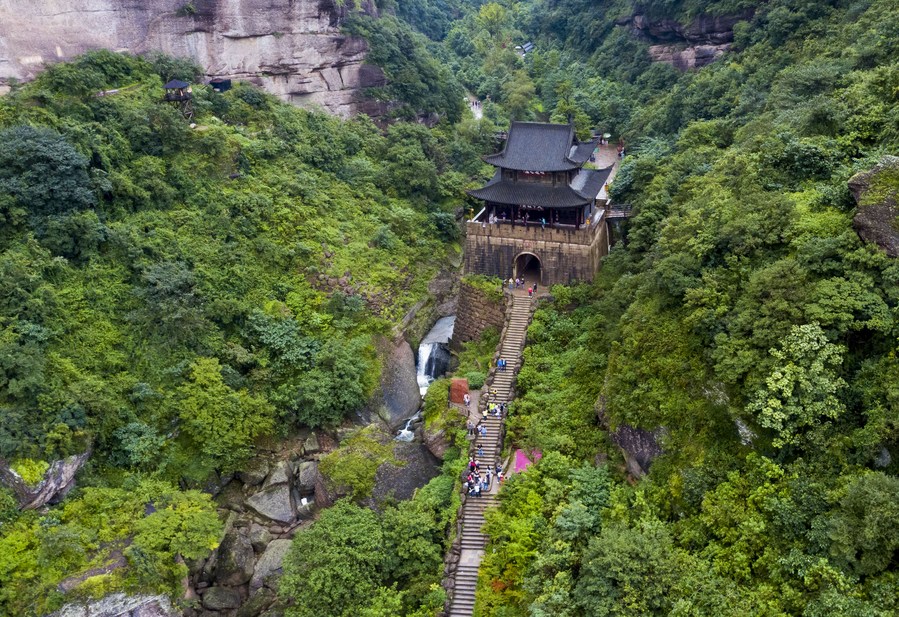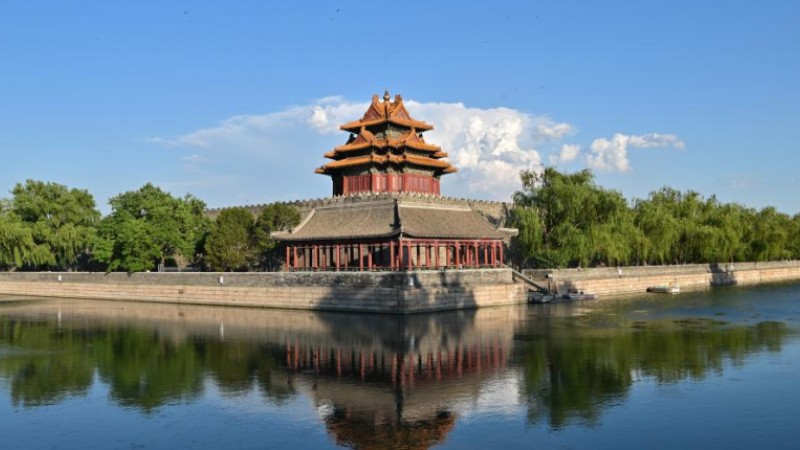Heritage protection breathes new life into China's millennia-old road system

Aerial photo taken on Sept. 17, 2017 shows Jianmen Pass scenic spot in Jian'ge County of southwest China's Sichuan Province. (Xinhua/Liu Chan)
CHENGDU, July 27 (Xinhua) -- Deep in the vast Qinling and Daba Mountains of central China, a feat of engineering stands tall. Numerous wooden planks supported by beams firmly anchored into cliffs create an intricate network of gallery roads, navigating the challenging terrain with sheer ingenuity.
Spanning over 1,000 km, this awe-inspiring road system is known as "Shudao," or roads of the Shu Kingdom. With a history of more than two millennia, Shudao winds its way through rugged mountains and tumultuous streams, connecting present-day Sichuan Province in the southwest with the northern Guanzhong Plain, once the heartland of ancient China.
"Climbing the Shudao is more difficult than reaching heaven," leaving one with no recourse but to "sit and sigh deeply, with a hand on the chest," Tang Dynasty (618-907) poet Li Bai once wrote. Such words capture the arduous journey and profound impact of this legendary road system.
"Shudao propelled the economic and cultural prosperity of Sichuan and the surrounding regions, linking the northern and southern routes of the Silk Road, and playing a significant role in the formation and flourishing of the diverse civilizations of ancient China, as well as the development and consolidation of a unified multi-ethnic nation," said Zhu Fuquan, a researcher on Shudao culture.
Nevertheless, Li Bai's poetic vision couldn't have foreseen that these once formidable roads, cutting through natural obstacles, would eventually draw flocks of people to experience the same breathtaking landscapes that once amazed ancient travelers.
The development and evolution of Shudao have transcended poetic imagination, transforming from a trade and military route into a pathway of culture, tourism and biodiversity. Its marvelous paths are adorned with a series of cultural treasures, including historical towns, temples and other relics.
The Cuiyunlang section of Shudao in Jian'ge County of Guangyuan City serves as a fine example. The ancient cypress trees along this section boast an average age of 1,050 years, with the oldest tree dating back approximately 2,300 years.
Since the Qin Dynasty (221-207 B.C.), people living along Shudao have planted and protected cypress trees, creating a tradition that continues to this day.
Presently, the Cuiyunlang section proudly harbors 7,803 ancient trees, with a staggering 7,778 being ancient cypress trees. It has become the most extensive and populous group of ancient trees lining a man-made pathway, with the longest recorded existence.
Since 2012, each outgoing county head of Jian'ge has taken the responsibility of conducting a thorough count and handover of the ancient cypresses, ensuring comprehensive and accountable management and conservation efforts.
Meanwhile, Jian'ge County has undertaken a comprehensive survey of all ancient cypresses in the region, establishing electronic information archives and implementing a system of identity-based management. Adhering to the principle of "customized conservation for each tree," dedicated measures for protection have been devised.
The protection of cultural heritage, such as Shudao, is also on President Xi Jinping's mind. He set aside time to learn about the protection of cultural relics on multiple domestic inspection tours.
During his inspection tour in Sichuan on Tuesday and Wednesday, Xi visited the Cuiyunlang section of Shudao and the Sanxingdui Museum in Deyang City, respectively. He learned about efforts in historical and cultural heritage inheritance and ecological conservation, progress in the excavation and research of historical and cultural heritage sites, as well as the protection and restoration of cultural relics.
In recent years, thanks to its remarkable transformation, the ancient Shudao has become a favored destination for tourists and history enthusiasts alike. They are drawn to embark on a captivating journey to explore this once-perilous route, marveling at the scenic spots that adorn its path and gaining a fascinating glimpse into the rich history and architectural achievements of the past.
During the five-day May Day holiday this year, Guangyuan City received a total of 2.66 million tourists, representing an increase of 25.1 percent compared to the pre-COVID level of the same period in 2019.
Chengdu, capital city of Sichuan, serves as the destination and starting point of the ancient Shudao system. From here, a "modern Shudao" is weaving its way to more of China's trade partners.
From this city, China-Europe freight trains journey westward, providing direct connections to Central Asia and various European countries. To the south, the New International Land-Sea Trade Corridor, supported by the Chengdu-Chongqing economic zone, has established links to destinations in 119 countries and regions, with 393 ports across the globe.
Photos
Related Stories
- Variety of cuisines served at Chengdu athletes' village
- Chengdu ready to hold successful FISU Summer World University Games
- Culture Fact: Six Chinese dishes you can't miss in Chengdu
- Bird-eye view of main stadium for 31st FISU World University Games
- Interview: Memories, new friendships part of games to bring home: Swedish competition manager
Copyright © 2023 People's Daily Online. All Rights Reserved.









